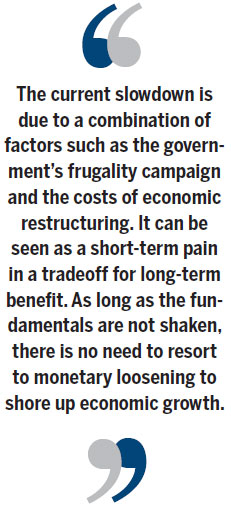Short-term pain but long-term gain
Updated: 2014-04-18 07:53
By Zhou Feng (China Daily Europe)
|
|||||||||||
Drastic measures not necessary as economic growth is still within the factored parameters in China
The Chinese economy grew 7.4 percent in the first quarter of the year, a new low.
Most of the other major economic indicators also showed a sluggish trend, with industrial added value growth up 8.7 percent, but down 0.8 percentage points from a year ago. Growth in fixed-asset investments slowed to 17.6 percent from 20.9 percent a year ago.

The sluggish trend exhibited by the major indicators has fueled concern that the world's second-largest economy will miss its yearly GDP growth target of 7.5 percent, a goal set a month ago during the annual meeting of the nations' top legislature.
The central government had sensed the slowdown, even before the figures were announced, and it has taken action.
This month, the State Council, China's cabinet, adopted a slew of pro-growth measures, dubbed as mini-stimulus. They included tax concessions to small and micro enterprises, shantytown reconstruction and more railway construction.
But some analysts think those are not enough, and are calling for a further loosening of monetary polices by lowering the reserve requirement ratio for banks or reducing the benchmark interest rate.
Their views are too pessimistic. Although first-quarter economic growth was not very pretty, there is no need to resort to monetary loosening. Instead, the due level of policy tightening, as underpinned by prudent money supply and the high level of required reserve ratio and interest rates, should be maintained to help improve the economic structure and create a good foundation for reforms.
The government may be more tolerant of economic slowdown than many thought. Strictly speaking, 7.5 percent growth may not be the bottom line. In Premier Li Keqiang's Government Work Report delivered last month, yearly growth goal was put at "about" 7.5 percent. This means the government can tolerate a short-term slowdown below 7.5 percent.
More importantly, the economic slowdown has not slipped to an alarming level. The current slowdown is due to a combination of factors such as the government's frugality campaign and the costs of economic restructuring. It can be seen as a short-term pain in a tradeoff for long-term benefit. As long as the fundamentals are not shaken, there is no need to resort to monetary loosening to shore up economic growth.
By withstanding the global financial crisis in 2008-09, the Chinese economy has become more resilient in its ability to deal with slower growth. Its trade sector, for example, has become used to operating with wafer-thin profit margins.
The labor market, a major concern of policymakers and the general public, has also become more tolerant toward a manufacturing slowdown. Last year, China's newly created jobs outnumbered those of the previous year, even though the economy grew at a slower pace.

China's working-age population has been shrinking in the past two years, a significant change that reduces employment pressures. In addition, a growing service sector means the country does not need to maintain a high degree of growth in manufacturing to boost employment. What haunts the labor market is the structural imbalance that sees a shortage of skilled labor but partial oversupply of entry-level service workers. In this sense, the task is not to aggressively boost overall GDP growth but to continue improving the service sector.
In addition, market liquidity is not that tight, so there is hardly any need to resort to further monetary loosening. The overnight Shanghai Interbank Offered Rate, a major indicator of borrowing costs, stayed below 3 percent for most of March and the first half of April, showing that funding is relatively inexpensive, at least for now. Yu'ebao, a popular online money-market product run by Alibaba, offers a yield of a bit more than 5 percent, coming down from nearly 7 percent at the beginning of the year. This also points to ample liquidity in the market, giving little reason for a drop in the bank reserve ratio or interest rates.
If the central bank reduces rates, the market may take it as a signal of monetary loosening. This will do no good to policymakers' effort to de-leverage the economy.
Since the central bank maintained a tough stance toward a credit crunch in the middle of last year, the market has anticipated that the tightening circle will be long-term. Based on that belief, lenders have become cautious in handing out loans.
From this year, banks and shadow banking agencies have gradually started to shun high-risk sectors such as property, coal, cement and steel. Coupled with measures such as short-term depreciation of the yuan, the tightening has helped drive liquidity from within the financial sector to real-economy sectors. This is conducive to restructuring and will promote a green economy.
If the bank reserve ratio and the interest rate are lowered, more money will be pumped into the market. Too much liquidity is likely to lead to a lending spree that dampens the success already achieved.
Of course, that is not to say monetary tightening should always be maintained at the current high level.
Slight loosening is needed if market liquidity drains quickly in the changing situation. For example, if too much money flows out of China, as reflected by the decrease in foreign exchange purchases, monetary policies should be loosened to ensure sufficient liquidity.
The author is a Shanghai-based financial analyst. The views do not necessarily reflect those of China Daily.
(China Daily European Weekly 04/18/2014 page12)
Today's Top News
EU hopes to strengthen climate co-op with China
64 dead in Korean ferry sinking
Nuclear plants to get the nod
No naval meet with Japan
Putin makes overture to incoming NATO chief
China on frontlines of cyber threat
China raises alert against cancer
William, Kate visit Australian air force base
Hot Topics
Lunar probe , China growth forecasts, Emission rules get tougher, China seen through 'colored lens', International board,
Editor's Picks

|

|

|

|

|

|





